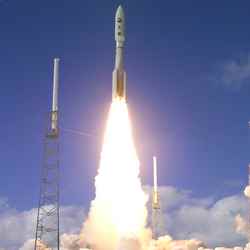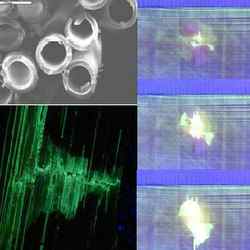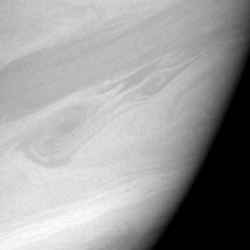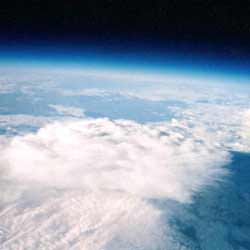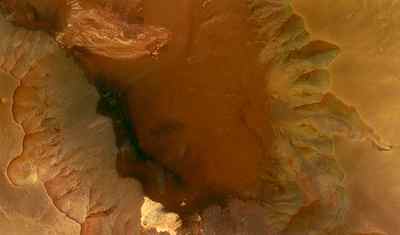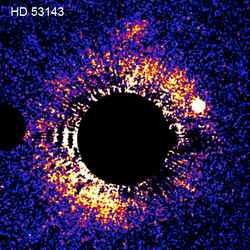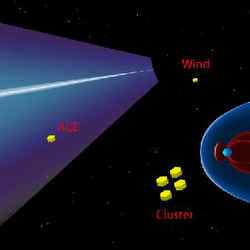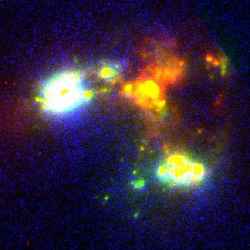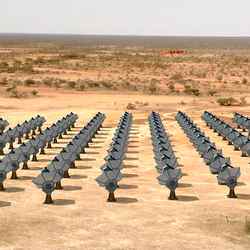
An image of how one element of the SKA might look. Image credit: Chris Fluke. Click to enlarge
European funding has now been agreed to start designing the world’s biggest telescope. The “Square Kilometre Array” (SKA) will be an international radio telescope with a collecting area of one million square metres – equivalent to about 200 football pitches – making SKA 200 times bigger than the University of Manchester’s Lovell Telescope at Jodrell Bank and so the largest radio telescope ever constructed. Such a telescope would be so sensitive that it could detect TV Broadcasts coming from the nearest stars.
The four-year Square Kilometre Array Design Study (SKADS) will bring together European and international astronomers to formulate and agree the most effective design. The final design will enable the SKA to probe the cosmos in unprecedented detail, answering fundamental questions about the Universe, such as “what is dark energy?” and “how did the structure we see in galaxies today actually form?”.
The new telescope will test Einstein’s General Theory of Relativity to the limit – and perhaps prove it wrong. It is certain to add to the long list of fundamental discoveries already made by radio astronomers including quasars, pulsars and the radiation left over from the Big Bang. By the end of this decade the design will be complete and astronomers anticipate building SKA in stages, leading to completion and full operation in 2020.
The SKA concept was first proposed to observe the characteristic radio emission from hydrogen gas. Measurements of the hydrogen signature will enable astronomers to locate and weigh a billion galaxies.
As the University of Manchester’s Prof Peter Wilkinson points out, “Hydrogen is the most abundant element in the universe, but its signal is weak and so a huge collecting area is needed to be able to study it at the vast distances that take us back in time towards the Big Bang”. To which Prof Steve Rawlings, University of Oxford, adds,”The distribution of these galaxies in space tells us how the universe has evolved since the Big Bang and hence about the nature of the Dark Energy which is now making the universe expand faster with time”.
Another target for the SKA is pulsars – spinning remnants of stellar explosions which are the most accurate clocks in the universe. A million times the mass of the Earth but only the size of a large city, pulsars can spin around hundreds of times per second. Already these amazing objects have enabled astronomers to confirm Einstein’s prediction of gravitational waves, but University of Manchester’s Dr Michael Kramer is looking further ahead. “With the SKA we will find a pulsar orbiting a black hole and, by watching how the clock rate varies, we can tell if Einstein had the last word on gravity or not”, he says.
Prof Richard Schilizzi, the International SKA Project Director, stresses the scale of the instrument needed to fulfil these science goals. “Designing and then building, such an enormous technologically-advanced instrument is beyond the scope of individual nations. Only by harnessing the ideas and resources of countries around the world is such a project possible”. Astronomers in Australia, South Africa, Canada, India, China and the USA are collaborating closely with colleagues in Europe to develop the required technology which will include sophisticated electronics and powerful computers that will play a far bigger role than in the present generation of radio telescopes. The European effort is based on phased array receivers, similar to those in aircraft radar systems. When placed at the focus of conventional mass-produced radio ‘dishes’, these arrays operate like wide-angle radio cameras enabling huge areas of sky to be observed simultaneously. A separate, much larger, phased array at the centre of the SKA will act like a radio fish-eye lens, constantly scanning the sky.
Funding for this global design programme has been provided by the European Commission’s Framework 6 ‘Design Studies’ programme, which is contributing about 27% of the total ?38M funding over the next four years. Individual countries are contributing the remainder. The UK has invested ?5.6M (?8.3M) funding provided by PPARC.
When coupled with the UK’s share of the EC contribution, then the UK’s overall contribution to the SKA Design Study (SKADS) programme is about 30% of the total.
The ?38M European technology development programme is funded by the European Commission and governments in eight countries led by the Netherlands, the UK, France and Italy. The programme is being coordinated by Ir. Arnold van Ardenne, Head of Emerging Technologies at The Netherlands ASTRON Institute. In van Ardenne’s view “the critical task is to demonstrate that large numbers of electronic arrays can be built cost effectively – so that our dreams of radio cameras and radio fish-eye lenses can be turned into reality”.
In the UK, a group of universities currently including Manchester, Oxford, Cambridge, Leeds and Glasgow, funded by PPARC, is involved in all aspects of the design but is concentrating on sophisticated digital phased arrays and the distribution and analysis of the enormous volumes of data which the SKA will produce. University of Cambridge’s Dr Paul Alexander makes the point that “the electronics in the SKA makes it very flexible and allows for completely new ways of scanning the sky. But to make it work will require massive computing power”. Designers believe that by the time the SKA reaches full operation, 14 years from now, a new generation of computers will be up to the task.
The geographical location of SKA will be decided in the mid-term future and several nations have already expressed interest in hosting this state of the art astronomical facility.
Original Source: PPARC News Release

